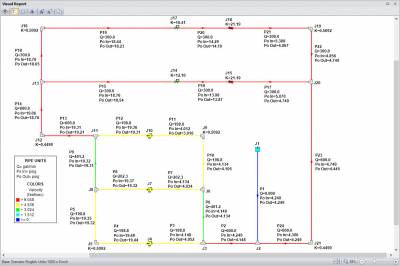AFT Blog
Using graphs that are stacked on top of each other is a great way to see the variation of several parameters at once and how one interacts with the others. There are several ways to create stacked graphs using the new graphing features in AFT applications, which I will cover here. I am going to start with the AFT Impulse model, ‘Pump Startup With Event Transient.imp’, which is installed in the Examples folder. I am going to use the ‘One Pump Start With One Running’ scenario. We will first compare the flow and pressure in the pipe path from the Supply...
The primary way to view results when using Impulse is through graphical data. With the release of AFT Impulse 6, the power of the graphing features has been greatly increased. With this enhanced capability comes additional complexity. It is a kin to the power and complexity of in-dash radio consoles in modern cars compared to the old stereo in my old Ford Pinto. To help users navigate the new capabilities of this powerful graphing tool, we have developed a ‘Graph Guide’ which points out the steps to accomplish many of the common tasks in creating, modifying and keeping graphs. The Graph...
The majority of steady-state, incompressible hydraulic models made in AFT Fathom that we see as Applications engineers typically converge very rapidly. However, every once in a while, that occasional AFT Fathom model arrives in our Support inbox that just won’t converge. At first glance, passing a graduate level course in compressible flow without ever missing an exam question may seem more likely than getting to the source of the convergence issue in one of these typically-monstrous models (like in Figure 1), but the tips below show that determining and correcting the problem preventing convergence is frequently straightforward and much easier than...
You’ve built your AFT Fathom or AFT Arrow model, defined all pipes and junctions, specified your fluid properties and defined your pressure boundary conditions. But for some reason, your predicted flows are still not matching measured data. AFT Fathom or AFT Arrow is properly solving the fundamental equations, but it is likely that something is off in the inputted data. In many cases, this is the pipe’s resistance. Many factors can alter a pipe’s resistance, but the two primary reasons resistance may be incorrect is (1) corrosion of the pipe over time, which increases a pipe’s absolute roughness and (2) the buildup of residue on the walls of the pipeline, known as scaling, which decreases a pipe’s inner diameter. This decrease in diameter is very important and will increase a pipe’s resistance dramatically. Now you have a dilemma. You can’t cut open your pipe to see how much scaling there is or how much your pipe has corroded. What is the condition of your pipe? Using AFT Fathom GSC or AFT Arrow GSC, you can find out!
Amongst the vast multitude of superbly efficient features within AFT Software, the customization and Database capabilities are certainly of significant importance. If you are not familiar with how to use the Databases within our software to manage your customized information, then getting familiar should be a top priority for what you learn how to do next in our software. Making effective use of Databases will save you and your team of AFT users incredible amounts of time! The vast amounts of data that you can customize within our software includes: Components (junctions)Fluid propertiesPipe materialsPipe insulationFittings & Losses (that get lumped into...
Often times when building larger network models, you may not be sure what the direction of the flow will be and running the model is the only way to determine the flow direction. In the below AFT Arrow model it might be hard to determine what way the flow convention is in some of the loops. After running this model there are cautions stating that flow is negative through junctions that may have loss factors that are dependent upon direction. What is the easiest way to fix this? You could compare your results, remember or make a table of what pipes...
Each AFT software product employs five Primary Window tabs in which you would build, define, and analyze the model of your system. Of these, the Visual Report window is incredibly useful in that you are able to overlay your model input or output parameters directly on top of the graphical layout of the system itself. This is an excellent feature to use when you want to provide the bottom line results to clients and colleagues at a high level (or a detailed level). Figure 1 is an example of what the Visual Report for a particular system might look like. As...


